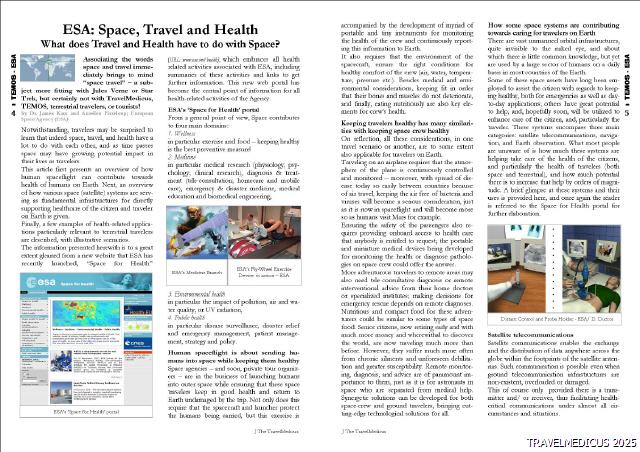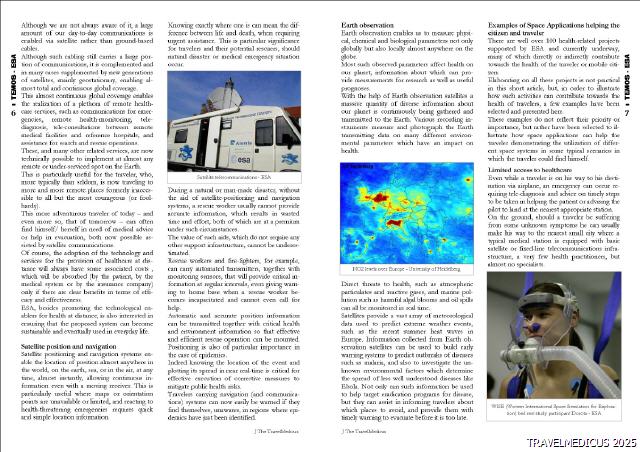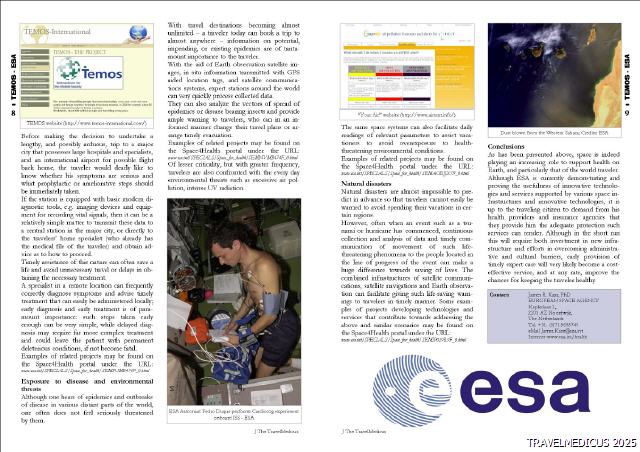Let's go Space...
What does Travel and Health have to do with Space?
Associating the words space and travel immediately brings to mind “space travel” – a subject more fitting with Jules Verne or Star Trek, but certainly not with TravelMedicus, terrestrial travelers, or tourists!
by Dr. James Kass and Aurelien Pisseloup; European Space Agency (ESA)

Notwithstanding, travelers may be surprised to learn that indeed space, travel, and health have a lot to do with each other, and as time passes space may have growing potential impact in their lives as travelers.
This article first presents an overview of how human spaceflight can contribute towards health of humans on Earth. Next, an overview of how various space (satellite) systems are serving as fundamental infrastructures for directly supporting healthcare of the citizen and traveler on Earth is given.
Finally, a few examples of health-related applications particularly relevant to terrestrial travelers are described, with illustrative scenarios.
The information presented herewith is to a great extent gleaned from a new website that ESA has recently launched, “Space for Health” www.esa.int/health , which embraces all health related activities associated with ESA, including summaries of these activities and links to get further information. This new web portal has become the central point of information for all health-related activities of the Agency.
ESA’s ‘Space for Health’ portal
From a general point of view, Space contributes to four main domains:
1. Wellness
in particular exercise and food – keeping healthy is the best preventive measure!
2. Medicine
in particular medical research (physiology; psychology; clinical research), diagnosis & treatment (tele-consultation; homecare and mobile care), emergency & disaster medicine, medical education and biomedical engineering,
3. Environmental health
in particular the impact of pollution, air and water quality, or UV radiation,
4. Public health
in particular disease surveillance, disaster relief and emergency management, patient management, strategy and policy.
Human spaceflight is about sending humans into space while keeping them healthy Space agencies – and soon, private tour organizers – are in the business of launching humans into outer space while ensuring that these space travelers keep in good health and return to Earth undamaged by the trip. Not only does this require that the spacecraft and launcher protect the humans being carried, but this exercise is accompanied by the development of myriad of portable and tiny instruments for monitoring the health of the crew and continuously reporting this information to Earth.
It also requires that the environment of the spacecraft, ensure the right conditions for healthy comfort of the crew (air, water, temperature, pressure etc.). Besides medical and environmental considerations, keeping fit in order that their bones and muscles do not deteriorate, and finally, eating nutritiously are also key elements for crew’s health.
Keeping travelers and space crew healthy

Keeping travelers healthy has many similarities with keeping space crew healthy.
On reflection, all these considerations, in one travel scenario or another, are to some extent also applicable for travelers on Earth.
Traveling on an airplane requires that the atmosphere of the plane is continuously controlled and monitored – moreover, with spread of disease today so easily between countries because of air travel, keeping the air free of bacteria and viruses will become a serious consideration, just as it is now in spaceflight and will become more so as humans visit Mars for example.
Ensuring the safety of the passengers also requires providing onboard access to health care that anybody is entitled to request; the portable and miniature medical devices being developed for monitoring the health or diagnose pathologies on space crew could offer the answer.
More adventurous travelers to remote areas may also need tele-consultative diagnosis or remote interventional advice from their home doctors or specialized institutes; making decisions for emergency rescue depends on remote diagnoses. Nutritious and compact food for these adventurers could be similar to some types of space food. Senior citizens, now retiring early and with much more money and wherewithal to discover the world, are now traveling much more than before. However, they suffer much more often from chronic ailments and unforeseen debilitation and greater susceptibility. Remote monitoring, diagnosis, and advice are of paramount importance to them, just as it is for astronauts in space who are separated from medical help. Synergetic solutions can be developed for both space-crew and ground travelers, bringing cutting-edge technological solutions for all.
How some space systems are contributing towards caring for travelers on Earth
There are vast unmanned orbital infrastructures, quite invisible to the naked eye, and about which there is little common knowledge, but yet are used by a large sector of humans on a daily basis in most countries of the Earth.
Some of these space assets have long been employed to assist the citizen with regards to keeping healthy, both for emergencies as well as daytoday applications; others have great potential to help, and, hopefully soon, will be utilized to enhance care of the citizen, and, particularly the traveler. These systems encompass three main categories: satellite telecommunications, navigation, and Earth observation. What most people are unaware of is how much these systems are helping take care of the health of the citizens, and particularly the health of travelers (both space and terrestrial), and how much potential there is to increase that help by orders of magnitude.
A brief glimpse at these systems and their uses is provided here, and once again the reader is referred to the Space for Health portal for further elaboration.
Satellite communications
Satellite communications enables the exchange and the distribution of data anywhere across the globe within the footprints of the satellite antennas. Such communication is possible even when ground telecommunication infrastructures are non-existent, overloaded or damaged.
This of course only provided there is a transmitter and/ or receiver, thus facilitating healthcritical communications under almost all circumstances and situations.
Although we are not always aware of it, a large amount of our day-to-day communications is enabled via satellite rather than ground-based cables.
Although such cabling still carries a large portion of communications, it is complemented and in many cases supplemented by new generations of satellites, mainly geostationary, enabling almost total and continuous global coverage.
This almost continuous global coverage enables the realization of a plethora of remote healthcare services, such as communications for emergencies, remote health-monitoring, telediagnosis, tele-consultations between remote medical facilities and reference hospitals, and assistance for search and rescue operations.
These, and many other related services, are now technically possible to implement at almost any remote or under-serviced spot on the Earth.
This is particularly useful for the traveler, who, more typically than seldom, is now traveling to more and more remote places formerly inaccessible to all but the most courageous (or foolhardy).
This more adventurous traveler of today – and even more so, that of tomorrow – can often find himself/ herself in need of medical advice or help in evacuation, both now possible assisted by satellite communications.
Of course, the adoption of the technology and services for the provision of healthcare at distance will always have some associated costs, which will be absorbed (by the patient, by the medical system or by the insurance company) only if there are clear benefits in terms of efficacy and effectiveness.
ESA, besides promoting the technological enablers for health at distance, is also interested in ensuring that the proposed system can become sustainable and eventually used in everyday life.
Satellite position and navigation
Satellite positioning and navigation systems enable the location of position almost anywhere in the world, on the earth, sea, or in the air, at any time, almost instantly, allowing continuous information even with a moving receiver. This is particularly useful where maps or orientation points are unavailable or limited, and reacting to health-threatening emergencies requires quick and simple location information.
Knowing exactly where one is can mean the difference between life and death, when requiring urgent assistance. This is particular significance for travelers and their potential rescuers, should natural disaster or medical emergency situation occur.
During a natural or man-made disaster, without the aid of satellite-positioning and navigation systems, a rescue worker usually cannot provide accurate information, which results in wasted time and effort, both of which are at a premium under such circumstances.
The value of such aids, which do not require any other support infrastructure, cannot be underestimated.
Rescue workers and fire-fighters, for example, can carry automated transmitters, together with monitoring sensors, that will provide critical information at regular intervals, even giving warning to home base when a rescue worker becomes incapacitated and cannot even call for help.
Automatic and accurate position information can be transmitted together with critical health and environment information so that effective and efficient rescue operation can be mounted. Positioning is also of particular importance in the case of epidemics.
Indeed knowing the location of the event and plotting its spread in near real-time is critical for effective execution of corrective measures to mitigate public health risks.
Travelers carrying navigation (and communications) systems can now easily be warned if they find themselves, unawares, in regions where epidemics have just been identified.
Earth observation

Earth observation enables us to measure physical, chemical and biological parameters not only globally but also locally almost anywhere on the globe.
Most such observed parameters affect health on our planet, information about which can provide measurements for research as well as useful prognoses.
With the help of Earth observation satellites a massive quantity of diverse information about our planet is continuously being gathered and transmitted to the Earth. Various recording instruments measure and photograph the Earth transmitting data on many different environmental parameters which have an impact on health.
Direct threats to health, such as atmospheric particulates and reactive gases, and marine pollution such as harmful algal blooms and oil spills can all be monitored in real time.
Satellites provide a vast array of meteorological data used to predict extreme weather events, such as the recent summer heat waves in Europe. Information collected from Earth observation satellites can be used to build early warning systems to predict outbreaks of diseases such as malaria, and also to investigate the unknown environmental factors which determine the spread of less well understood diseases like Ebola. Not only can such information be used to help target eradication programs for disease, but they can assist in informing travelers about which places to avoid, and provide them with timely warning to evacuate before it is too late.
Examples of Space Applications
Examples of Space Applications helping the citizen and traveler
There are well over 100 health-related projects supported by ESA and currently underway, many of which directly or indirectly contribute towards the health of the traveler or mobile citizen.
Elaborating on all these projects is not practical in this short article, but, in order to illustrate how such activities can contribute towards the health of travelers, a few examples have been selected and presented here.
These examples do not reflect their priority or importance, but rather have been selected to illustrate how space applications can help the traveler demonstrating the utilization of different space systems in some typical scenarios in which the traveler could find himself.
Limited access to healthcare
Even while a traveler is on his way to his destination via airplane, an emergency can occur requiring tele-diagnosis and advice on timely steps to be taken in helping the patient or advising the pilot to land at the nearest appropriate station.
On the ground, should a traveler be suffering from some unknown symptoms he can usually make his way to the nearest small city where a typical medical station is equipped with basic satellite or fixed-line telecommunications infrastructure, a very few health practitioners, but almost no specialists.
Before making the decision to undertake a lengthy, and possibly arduous, trip to a major city that possesses large hospitals and specialists, and an international airport for possible flight back home, the traveler would dearly like to know whether his symptoms are serious and what prophylactic or ameliorative steps should be immediately taken.
If the station is equipped with basic modern diagnostic tools, e.g. imaging devices and equipment for recording vital signals, then it can be a relatively simple matter to transmit these data to a central station in the major city, or directly to the travelers' home specialist (who already has the medical file of the traveler) and obtain advice as to how to proceed.
Timely assistance of this nature can often save a life and avoid unnecessary travel or delays in obtaining the necessary treatment.
A specialist in a remote location can frequently correctly diagnose symptoms and advise timely treatment that can easily be administered locally; early diagnosis and early treatment is of paramount importance: such steps taken early enough can be very simple, while delayed diagnosis may require far more complex treatment and could leave the patient with permanent deleterious conditions, if not become fatal.
Examples of related projects may be found on the Space4Health portal under the URL: www.esa.int/SPECIALS/Space_for_health/SEMPUMB474F_0.html
Exposure to disease and environmental threats
Although one hears of epidemics and outbreaks of disease in various distant parts of the world, one often does not feel seriously threatened by them.
With travel destinations becoming almost unlimited – a traveler today can book a trip to almost anywhere – information on potential, impending, or existing epidemics are of tantamount importance to the traveler.
With the aid of Earth observation satellite images, in situ information transmitted with GPS aided location tags, and satellite communications systems, expert stations around the world can very quickly process collected data.
They can also analyze the vectors of spread of epidemics or disease bearing insects and provide ample warning to travelers, who can in an informed manner change their travel plans or arrange timely evacuation.
Examples of related projects may be found on the Space4Health portal under the URL: www.esa.int/SPECIALS/Space_for_health/SEMNVMB474F_0.html
Of lesser criticality, but with greater frequency, travelers are also confronted with the every day environmental threats such as excessive air pollution, intense UV radiation.
The same space systems can also facilitate daily readings of relevant parameters to assist vacationers to avoid overexposure to healththreatening environmental conditions.
Examples of related projects may be found on the Space4Health portal under the URL: www.esa.int/SPECIALS/Space_for_health/SEMAOEJJX7F_0.html
Natural disasters
Natural disasters are almost impossible to predict in advance so that travelers cannot easily be warned to avoid spending their vacations in certain regions.
However, often when an event such as a tsunami or hurricane has commenced, continuous collection and analysis of data and timely communication of movement of such lifethreatening phenomena to the people located in the line of progress of the event can make a huge difference towards saving of lives. The combined infrastructures of satellite communications, satellite navigations and Earth observation can facilitate giving such life-saving warnings to travelers in timely manner. Some examples of projects developing technologies and services that contribute towards addressing the above and similar scenarios may be found on the Space4Health portal under the URL: www.esa.int/SPECIALS/Space_for_health/SEMIP029R9F_0.html
Conclusions
As has been presented above, space is indeed playing an increasing role to support health on Earth, and particularly that of the world traveler. Although ESA is currently demonstrating and proving the usefulness of innovative technologies and services supported by various space infrastructures and innovative technologies, it is up to the traveling citizen to demand from his health providers and insurance agencies that they provide him the adequate protection such services can render. Although in the short run this will require both investment in new infrastructure and efforts in overcoming administrative and cultural barriers, early provision of timely expert care will very likely become a costeffective service, and at any rate, improve the chances for keeping the traveler healthy.
(Journal The TravelMedicus - update July, 10. 2018)